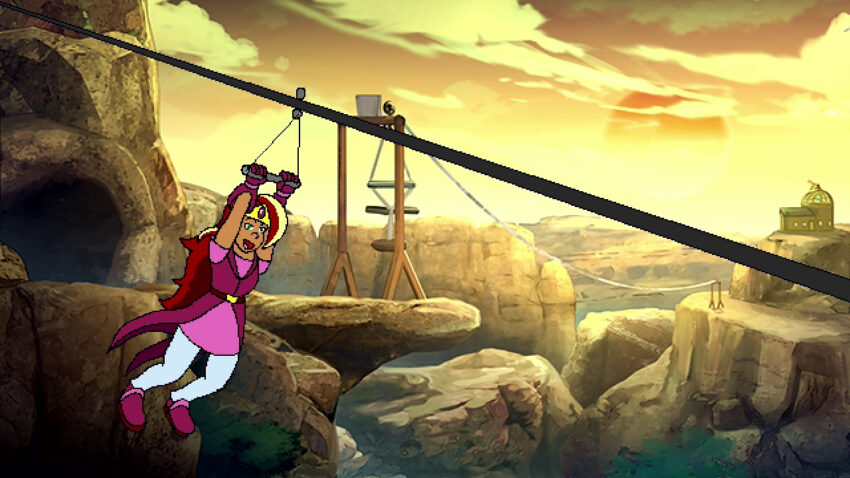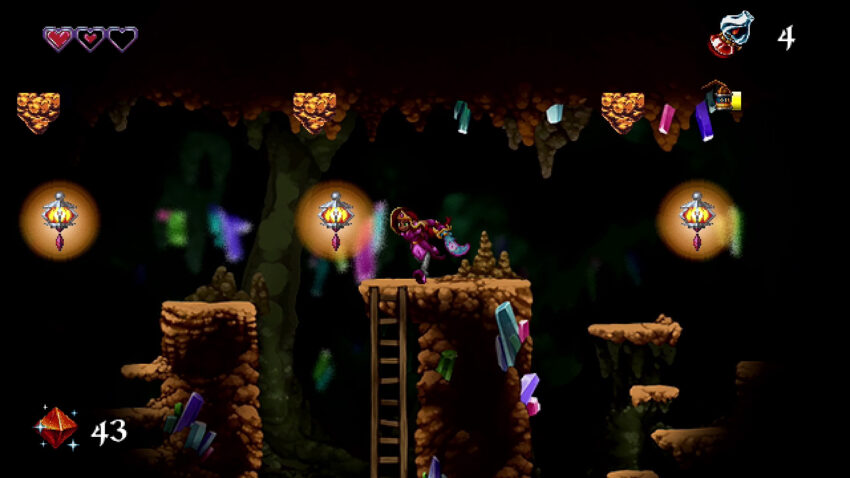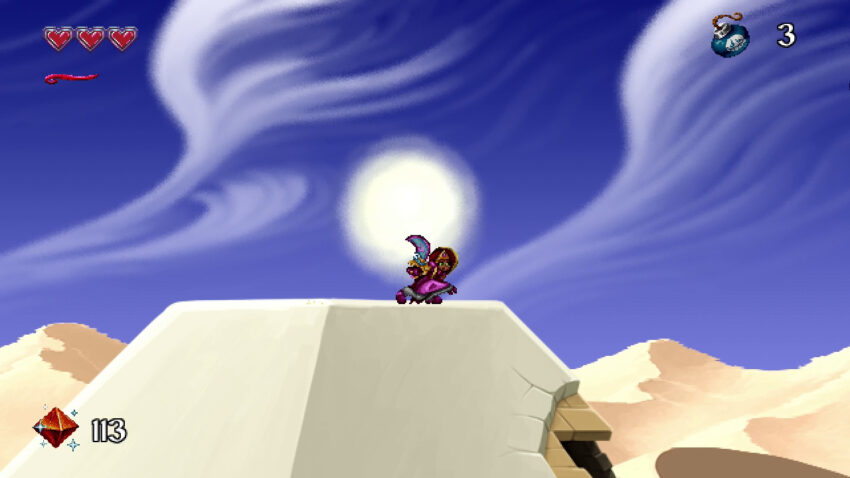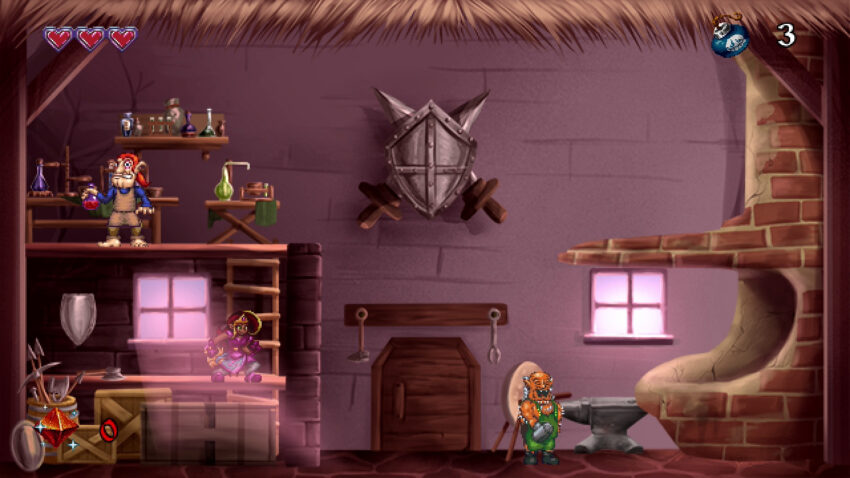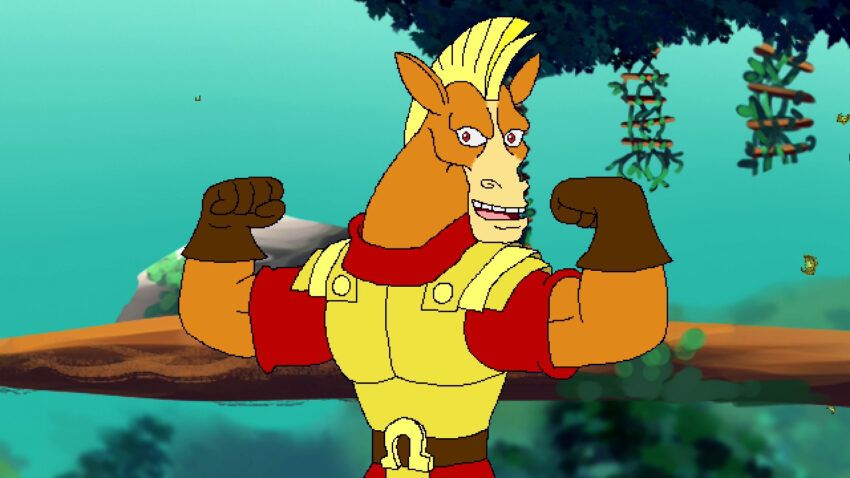Review: Arzette: The Jewel of Faramore is a Charming Homage to a Piece of Zelda History that Nintendo Wants You to Forget
Posted on February 23 2024 by Nick Miller
In the current climate of the video game industry, it isn’t uncommon to see a litany of remakes, remasters, and spiritual successors flooding the market. Bringing beloved classics into the modern age keeps them relevant to newer audiences and broadens their appeal. What most of these games have in common, though, is that they draw inspiration from games that are revered, games that are considered cult classics, or games that were praised at the time of their release but have since started to show their age.
What if a game came along that chose to celebrate a different kind of source material? What if a game dared to do the impossible by drawing its inspiration from two of the most criticized titles in video game history? What if a game was a spiritual successor to Link: The Faces of Evil and Zelda: The Wand of Gamelon?
A Blemish on Nintendo’s History
Simultaneously released in 1993, The Faces of Evil and The Wand of Gamelon were entries in the Legend of Zelda series created as part of a collaborative effort between Nintendo and Phillips Interactive Media for Phillips’ new Compact Disc-Interactive players (CD-i for short). Despite receiving some surprisingly mixed reviews when they first released, these games have since been universally panned for, among other things, their stiff, awkward controls and their goofy animated cutscenes. The latter was particularly jarring for Zelda fans who were accustomed to the mainline series’ more serious and mature tone.
Thanks to YouTubers and online reviewers keeping these games relevant through memes, video essays, and the like, The Faces of Evil and The Wand of Gamelon have faced increasing notoriety over the years.
This heavy criticism, coupled with his own experience in game design, caused Seedy Eye Software founder Seth Fulkerson to feel empathy for these games. This empathy motivated Fulkerson to create fan remasters of The Faces of Evil and The Wand of Gamelon, a project which acted as a springboard for the creation of an entirely new game that would act as a spiritual successor to the Zelda CD-i titles.
Thus, Arzette: The Jewel of Faramore was born. Developed by Seedy Eye Software, Arzette marks the first self-published original title from Limited Run Games.
A Simple, Serviceable Tale
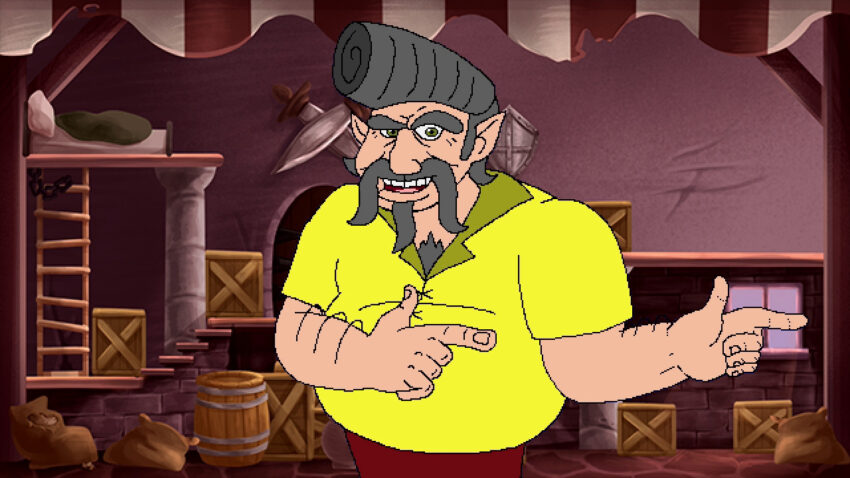
Like the CD-i games that came before it, Arzette‘s opening establishes a unique tone within seconds of starting the game, both in its presentation and in its story.
Upon booting up the game, an animated cutscene, reminiscent of Zelda‘s CD-i style, plays. It explains how Daimur, demon Lord of the land of Oakurin, had wreaked havoc across the land of Faramore with the help of Duke Nodelki, Lord of the Island nation of Amelog. Using the magic of the Jewel of Faramore, King Rahkin of Faramore, Princess Arzette, the king’s advisor Wogram, and hero Dail joined forces to seal Daimur away in the Book of Oakurin. This caused the Jewel of Faramore to shatter into five pieces. And for his crime of treason, Duke Nodelki was forced into servitude.
Ten years later, Duke Nodelki has secretly assembled the five pieces of the Jewel of Faramore. Using the power of the reunited Jewel, Nodelki releases Daimur back into the world. Daimur then charges his minions with protecting the shards of the Jewel of Faramore so that it won’t be used to seal him away again. With King Rahkin growing old and Dail leaving hero work behind, Princess Arzette steps up to the plate. Wogram describes the trials that lie before Arzette in her journey. He explains that she must collect Sacred Candles to burn Dark Tapestries that act as barriers to certain areas around Faramore. Likewise, Arzette must relight Sacred Beacons to dispel Daimur’s Dark Fog, which in turn opens new paths for Teleportation Scrolls that are used to traverse the land.
So, as Daimur exacts his revenge on the land of Faramore, Princess Arzette sets out on a quest to collect the missing shards, dispel the Dark Fog, and defeat Daimur once and for all.
If that sounds like a lot to take in all at once, don’t worry; you’re not alone. When I booted up this game for the first time at 10:30 PM on a workday, I was immediately lost in the clutter. All of this information is dumped on the player before they press a single button. There are a lot of names and proper nouns thrown around rapid fire; it can be overwhelming.
Don’t be discouraged, though. When you strip it down to the basics, this really is a simple game with a simple story. All you really need to know to get started is that Daimur is the bad guy, that Arzette is the good guy (or girl), and that, if you see something interesting while you’re playing, check it out, because it will probably be important later. That’s enough motivation to get you going, and the rest you’ll figure out along the way.
Action Platforming at Its Finest
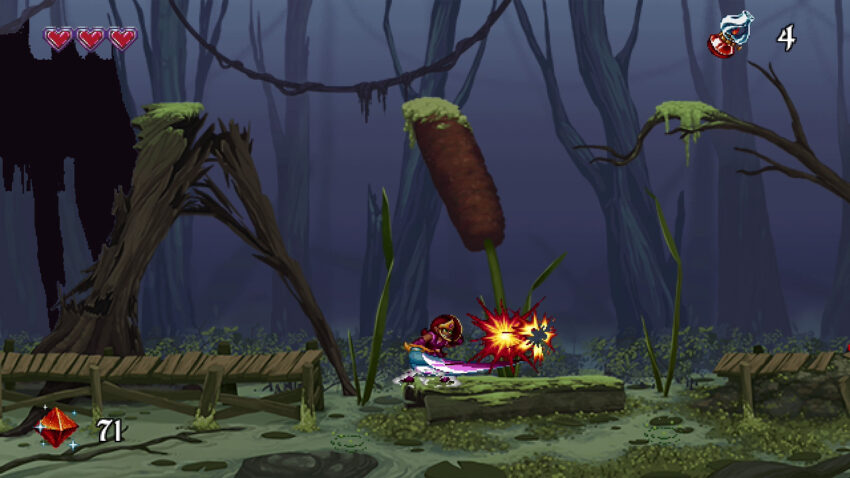
Arzette is a 2D action platformer with linear levels and a Metroidvania mode of progression. Starting with only her sword, Arzette collects new gear as she explores each level and fulfills quests for the residents of Faramore, which allows her to open locked paths in previously explored areas.
I’m happy to say that Arzette actually performs exactly how you’d expect a modern action platformer to play. Arzette’s movement is fast and responsive, with perfect midair control. Her sword is quick on the draw, and it never struggles to connect with enemy hitboxes. Be careful though! Enemies have invincibility frames that make swinging your sword recklessly detrimental to your success in combat. They can and they will counterattack if given the chance. However, all of the standard enemies are fair and are well-suited to Arzette’s abilities.
Likewise, platforms are placed in a manner that is reasonable for Arzette’s move set. They are easy to identify and they never require pixel-perfect inputs to reach. The platforming is so accessible that, if I had any critique of it at all, it would be that I wish it was more of a challenge. The player has so much control over Arzette that even landing on a moving target will rarely pose a threat.
One gameplay element that admittedly had me worried at first was the Metroidvania style of progression. In a game that’s comprised of disconnected linear levels, it would be very easy for progression to trend towards tedium. If Arzette’s levels were longer or if movement was slower, this would definitely be the case. Thankfully, skilled players can clear levels in just a few minutes. Each visit to an area will carry with it an increased familiarity with enemy and platform placements that will ensure that each playthrough of a level will be faster than the last. Even after playing through some levels five or six times, they never got old. However, if the game were longer, they may well have worn out their welcome.
A Wacky Cast of Characters
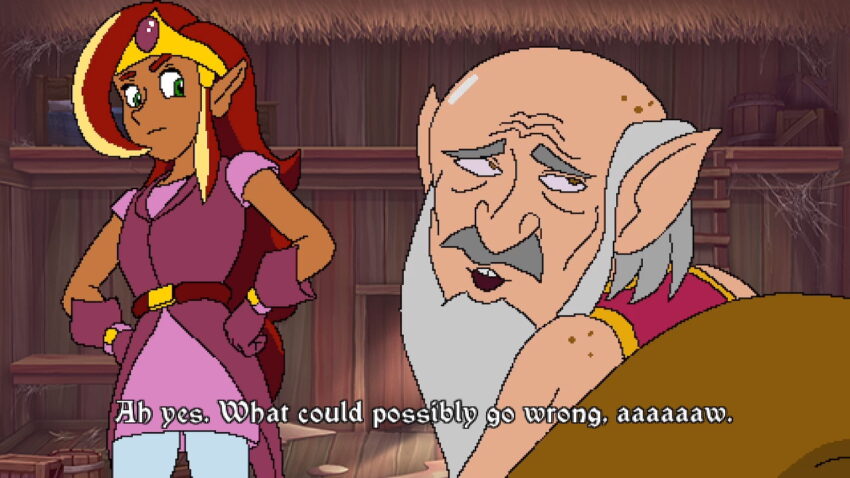
Exploring each level in depth and backtracking are rewarded in large part due to the insane cast of characters you encounter in your travels. Finding new residents of Faramore to interact with will always give you something to look forward to, and rarely are they just for show. Most of them will have a side quest for you, or they will provide you with some aid in your own quest. From a werewolf with an eye for jean shorts to a hermit who has an odd fascination with your flesh, you never know what you’ll cross paths with next. Finding new characters never disappointed me, and it was always an exciting motivator for exploration.
Among this cast of characters are Daimur’s minions, whom he has entrusted with the shards of the Jewel of Faramore. A yuppie dragon that hoards gold and a centaur centurion who makes horse puns are just a few of the enemies you’ll face, and they are just as goofy as the rest of the cast.
Unfortunately, as creative as the boss’ character designs are, every single one of them is severely lacking when it comes to their actual fights. These are, with no exaggeration, some of the easiest bosses I’ve ever faced in a video game. In one particular fight, I literally stood in the middle of the arena and held block to reflect the boss’ attacks back at them. That was it; that was the whole fight.
From a late-game boss, I really expected more, especially considering the level leading up to them was more difficult than the fight itself. I understand that Arzette was never meant to be a white-knuckle challenge, but a little more difficulty, or more complex move sets from the bosses, would have made these fights more enjoyable and could have left the player with a genuine sense of accomplishment.
More Than Just an Imitation
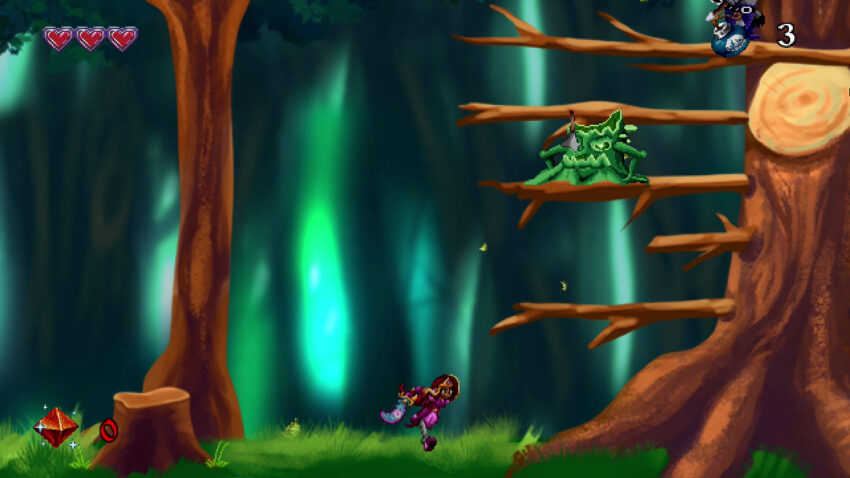
It would be impossible to talk about Arzette without mentioning the art direction. This game has a distinct style that calls back to the Zelda CD-i games and it is incredibly charming. This was accomplished in part thanks to the artistic talents of Ron Dunleavy — the original artist for Zelda‘s CD-i games — who lent a hand in drawing the overworld map and fleshing out the land of Faramore.
Each level has a hand-drawn style that often looks like something you’d find hanging in a high school art room. I promise that isn’t a criticism; it’s a genuine compliment. It’s such a unique style and the game is more than happy to embrace it, which lends to its charm.
There’s also no disconnect between the backdrop and a level’s interactive elements. Platforms and environmental hazards meld into the background, which goes a long way towards immersing the player in the world. Each platform has a practical purpose and isn’t just arbitrarily hanging in space so the player has something to stand on. Unlike many other 2D platformers, Arzette‘s stages never feel like an obstacle course separate from the worlds they represent. They feel real and lived-in, even during the more outlandish moments.
Speaking of outlandish, when it comes to art style, nothing in Arzette is more memorable than its animated cutscenes. Developer Seth Fulkerson gave the artists full creative freedom with the stipulation that animations be made in the same resolution, frame rate, and color palette as the CD-i titles that inspired them. As such, some of these cutscenes are unlike anything you’ll see in other games. The residents of Faramore look like they’re drawn in Microsoft Paint, with flat colors and rough edges, but don’t let that turn you away. The camp has an incredible charm to it that kept me smiling ear to ear every time one of these goofballs graced my screen.
These animations wouldn’t be complete however without the voice talents who breathed life into Arzette’s zany cast of characters. Joined by Jeffrey Rath and Bonniejean Wilbur, the original voices of the CD-i’s Link and Zelda, respectively, the voice work in Arzette is nothing short of perfect for a game like this. It is clear that the voice actors dove headfirst into these characters and had a ton of fun in the process. This kind of passion and fun rubs off on the player, so much so that Arzette wouldn’t be the game it is today without them.
Overcoming the Burden of the Source Material
Arzette is a unique game, to say the least, not just in its presentation but in the fact that it is difficult to criticize. I’m not saying it’s perfect, but when a game’s inspiration is near-universally panned, it can be hard to differentiate between what is paying homage to the source material, and what is developer oversight. Is the lack of difficulty a result of the Zelda CD-i games being generally easy if given modern upgrades? Could a game have truly paid homage to the CD-i games if they stripped away the frequent backtracking? If the game has a “bad” quality, is it only that way as a result of what inspired it? These were some of the questions that I had to grapple with while playing Arzette. I eventually came to the conclusion that, despite Arzette’s source of inspiration, it was a modern game and it should be judged as such. So, in addition to what was already said, there are some criticisms worth mentioning.
First is the limited variety of enemies. Mechanically, the enemies all function well. They all have fun and interesting designs, but there aren’t that many of them. This often causes enemy designs to clash with the environment. Axe-wielding tree stumps and ghost pirates are a natural fit for a swamp or a beach, respectively, but they break the immersion a bit when you find them at the top of a snowy mountain peak. A larger enemy roster would have helped keep their designs consistent with the environment, as well as keep players on their toes as they encounter new enemies with new attack patterns. With few exceptions, what you see in the first few levels is what you’ll see the entire game.
Second, gear upgrades are often overpowered. Early in the game, Arzette will gain the ability to block ranged attacks. This is a welcomed upgrade as ranged attacks will be the cause of most of your deaths early on. However, you can block any ranged attack with just the press of a button and with no timing or resource costs required. This ability alone saps the difficulty out of enemies who attack at a distance and contributes to the overall easiness of boss fights. The heroine’s block becomes even more overpowered when it gets upgraded to reflect enemy attacks, which makes this passive, no-cost ability capable of dealing damage. Having Arzette’s block come at the expense of souls (a secondary in-game currency that acts as ammunition for certain items) or making it a timed ability so that players can’t just hold the button in when anticipating an enemy attack, would prevent it from being a one-size-fits-all solution for ranged attacks.
Arzette’s Smart Gun is another piece of equipment that is similarly overpowered. It allows Arzette to break colored barriers in the environment and attack enemies at a distance. If the Smart Gun was just used to break enemy armor (which it does) and open barriers, it would be fine. The problem is that it can deal damage at a distance, which trivializes most enemies’ attack patterns. Although it relies on souls as ammunition, souls are regularly dropped by enemies; and at one soul per shot with a maximum capacity of 250 souls, you won’t be running out any time soon. The Smart Gun’s damaging capabilities also make a late-game sword upgrade redundant, and takes some of the excitement out of collecting it.
My last criticism relates to the game’s final act. Without getting into spoilers, I am not exaggerating when I say that Arzette’s final act is one of the most anticlimactic endings to a game I have ever played. This was one of those moments when I caught myself asking, “Was this a decision inspired by the CD-i games, or did developers feel this was a fitting conclusion?” Either way, by today’s gaming standards, the ending just fell flat. However, it wasn’t enough to sour my overall opinion of the game. Arzette is truly one of those games where the journey is worth much more than the destination.
Conclusion: Humor Elevated by Admiration

So, Arzette: The Jewel of Faramore dared to do the impossible, and it succeeded. It managed to adapt two of the most criticized games in history into something that is not just tolerable, but something that was an absolute joy to play!
Seedy Eye was able to pull this off because, as Seth Fulkerson put it, “This is a love letter, not a mockery game.” Arzette comes from a place of pure respect and appreciation. As such, it has the ability to poke fun at Zelda‘s CD-i games without coming across as mean-spirited or derogatory. Arzette embraces the over-the-top characters and camp that were so heavily criticized in its predecessors. This makes it a truly unique game in that many of the qualities that made its CD-i inspirations the butt of jokes are exactly the same things that make Arzette wonderful.
This game is chock full of humor, but it never feels overdone. Despite the outlandish nature of Faramore and its citizens, everyone plays it straight, as if the wackiness is normal. The humor just comes naturally and it never calls attention to itself; no one pauses for laughter or outright tells a joke. The game is just funny because it never feels like it’s trying to be.
The shining accomplishment of Arzette’s development was in bringing a modern understanding of game design to the infamous Zelda CD-i formula. If you’re familiar with the CD-i titles, then Arzette will feel familiar in all the right ways. The atmosphere of the old games remains very much intact, but with gameplay that is fresh and fun. Arzette is everything The Faces of Evil and The Wand of Gamelon should have been and more. If anything, Arzette: The Jewel of Faramore is evidence that even the worst games can be made right with a few tweaks and some proper context.
Zelda Dungeon’s Score: 8/10
Arzette: The Jewel of Faramore is available now on Nintendo Switch, Steam, and all other major platforms. You can also pre-order a physical copy through Limted Run Games.
If you’d like to see more of Arzette and Seedy Eye Software, you can check out the upcoming PAX East panel, where Seth Fulkerson will take stage to discuss the Zelda CD-i games.
Do you plan to pick up Arzette: The Jewel of Faramore? Let us know in the comments below!
This review was conducted on the Nintendo Switch. Review copy provided by Limited Run Games.

Nick is a writer for Zelda Dungeon and a longtime fan of the Zelda franchise. In his free time, he enjoys fishing, archery, skateboarding, and some good ol’ fashioned family time. He’s an advocate for physical media and an avid video game collector. His favorite Zelda game is Ocarina of Time, though Breath of the Wild and the Link’s Awakening remake are close contenders.



